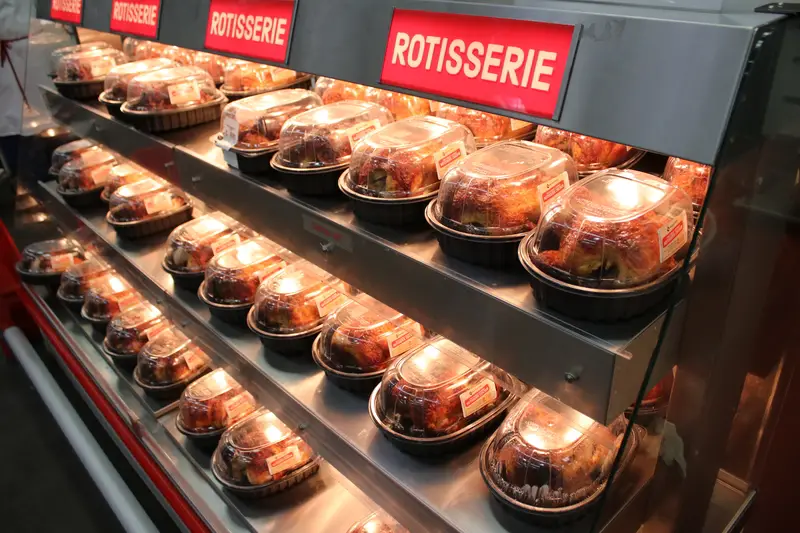Every week, millions of Americans grab a rotisserie chicken from their local grocery store, trusting it’s fresh and ready to eat. These golden birds have become a dinner staple since the 1990s, offering a quick solution for busy weeknight meals. However, not all rotisserie chickens are created equal, and knowing what warning signs to watch for can save you from a disappointing meal or worse.
The chicken looks discolored or has strange patches
A properly cooked rotisserie chicken should have beautiful golden-brown skin that looks appetizing from across the store. When the skin starts showing gray or green patches, that’s your first warning that something isn’t right. These unusual colors often indicate bacterial growth has begun, making the chicken unsafe to eat. The discoloration might appear as slimy patches or areas where the skin looks dull and lifeless instead of the usual glossy finish.
Sometimes the problem isn’t immediately obvious at the store but becomes clear once you get home under better lighting. If you cut into the chicken and find gray or green areas in the meat itself, it’s time to throw it out. The USDA confirms that cooked chicken can range from white to pink to tan, but anything beyond those normal color variations signals spoilage. Trust your instincts – if the color looks off, don’t risk it.
The skin appears cracked and is tearing apart
Fresh rotisserie chicken should have tight, intact skin covering the entire bird. When you see chickens with skin that’s cracking or peeling away in sections, it usually means the meat has dried out significantly. This happens when chickens sit under heat lamps too long or were overcooked to begin with. The skin acts as a natural moisture barrier, so when it starts breaking down, all those delicious juices escape.
Pay special attention to the joints and areas where the legs meet the body, as these spots often show cracking first. Once the skin tears, it creates a cycle where more moisture escapes, causing additional cracking and drying. What you’ll end up with is tough, chewy meat that’s nothing like the juicy chicken you were expecting. Skip any birds that look like they’re falling apart at the seams.
There are too many dark or burnt patches
A few darker spots on rotisserie chicken aren’t necessarily cause for alarm, but extensive dark patches or obviously burnt areas should make you think twice. Overcooked chicken becomes tough and unpleasant to eat, losing the tender texture that makes rotisserie chicken so popular. Sometimes these dark areas result from uneven cooking or chickens that spent too much time rotating on the spit.
Before writing off a chicken entirely, check if the store uses dark glazes like barbecue or teriyaki sauce, which can create darker patches that are perfectly normal. However, if you see areas that look genuinely burnt or charred, especially combined with cracked skin, it’s better to choose a different bird. Burnt chicken often contains compounds that don’t taste good and can make the entire meal less enjoyable.
The chicken gives off an unpleasant smell
Fresh rotisserie chicken should smell amazing – that’s part of what draws customers to the deli section in the first place. When a chicken starts going bad, it develops a sour or off-putting odor that’s quite different from the rich, savory aroma of properly cooked poultry. This smell indicates bacterial growth has begun, making the chicken potentially dangerous to eat.
Don’t feel embarrassed about giving a chicken a good sniff before buying it. Sometimes the aroma from fresh chickens can mask the smell of spoiled ones nearby, so it’s worth checking each individual bird. If you detect anything that reminds you of rotten eggs or just seems “off,” trust that instinct and choose a different chicken. A few seconds of checking can save you from a ruined dinner.
The packaging looks damaged or compromised
The container holding your rotisserie chicken serves an important purpose beyond just making it easy to carry home. Damaged packaging can allow bacteria to contaminate the chicken or indicate that the bird wasn’t handled properly by staff or other customers. Look for obvious tears in plastic containers, dents that might have compromised the seal, or aluminum foil wrapping that’s been punctured.
Even if the chicken inside looks fine, damaged packaging suggests the food hasn’t been treated with proper care. Check that any seals look intact and haven’t been tampered with by previous shoppers. If someone opened the container to inspect the chicken and didn’t buy it, that’s not a bird you want to take home either.
The chicken feels unusually light for its size
When you pick up a rotisserie chicken, it should have some serious heft to it. A chicken that feels surprisingly light compared to others of similar size has likely lost a significant amount of its natural juices. This happens when chickens sit under heat lamps for extended periods, essentially continuing to cook and dry out even after they’re done.
Most whole rotisserie chickens weigh between 4 and 5 pounds, so they should feel substantial in your hands. Don’t be shy about comparing weights by lifting different chickens to find the heaviest one available. That extra weight usually translates to juicier, more flavorful meat that won’t disappoint when you get home.
There’s either no juice or way too much liquid
The amount of liquid in the bottom of a rotisserie chicken container tells a story about the bird’s freshness and quality. No juice at all usually means the chicken has dried out completely, while excessive pooling of liquid can indicate the opposite problem – that juices have escaped from dried-out meat that can no longer hold onto moisture.
A small amount of clear drippings is normal and actually desirable, showing the chicken still has some of its natural juices. However, when you see a liquid bath at the bottom of the container, those are juices that should be inside the meat making it tender and flavorful. The sweet spot is a chicken with minimal but visible drippings, indicating it’s been properly cooked and hasn’t been sitting around too long.
The chicken feels cold to the touch
Rotisserie chickens should be kept warm under heat lamps to maintain both food safety and eating quality. When you find a chicken that feels cold or only lukewarm, it means the heating system isn’t working properly or the bird has been sitting out too long. Cold rotisserie chicken isn’t just less appealing to eat – it can also be entering the danger zone where bacteria multiply rapidly.
The USDA recommends that cooked food shouldn’t remain in the danger zone (between 40 and 140 degrees Fahrenheit) for more than two hours. A cold chicken suggests it’s been sitting at unsafe temperatures and could make you sick. Always choose the warmest chicken available, and if they all feel cold, consider shopping elsewhere or asking when fresh ones will be ready.
The ingredient list contains suspicious additives
While rotisserie chicken seems like a simple product, many stores inject their birds with various solutions to enhance appearance, extend shelf life, or add weight. Reading the ingredient label might reveal a surprisingly long list of additives, preservatives, and sodium-heavy compounds that you’d never use at home. Some chickens contain so much added sodium that they’re essentially pre-brined beyond what most people would prefer.
Look for chickens with shorter ingredient lists that stick to basics like chicken, salt, and recognizable spices. Suspicious ingredients might include various phosphates, artificial colors, or preservatives with complicated chemical names. If you can’t pronounce half the ingredients or the list is surprisingly long for what should be a simple roasted chicken, consider looking for a cleaner option or cooking your own at home.
Next time you’re standing in front of that tempting display of rotisserie chickens, take a moment to inspect before you buy. A few extra seconds of examination can mean the difference between a satisfying dinner and a disappointing waste of money. Remember that the best rotisserie chicken should look, smell, and feel like something you’d be proud to serve at your own dinner table.

